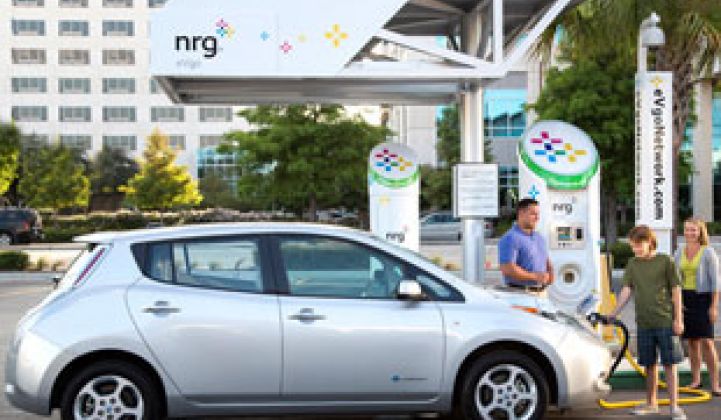Electric-vehicle drivers may be waiting a while for the superhighway of charging stations that will eventually run up, down and across California.
The Associated Press reported on Thursday that only 10 percent of NRG Energy’s electric car chargers due for installation by December have been installed. Instead of more than 1,000 EV-ready parking spots, only 110 have been completed by NRG’s eVgo. There are plans for 10,000 parking spots equipped with charging stations by the end of 2016.
The plans came about when the California Public Utilities Commission (CPUC) ordered NRG Energy Inc. to fund a $100 million network of charging stations for electric vehicles, with another $20 million for ratepayer relief. The deal was a way to settle claims against NRG’s predecessor Dynegy, which had failed to fulfill long-term power contracts during California’s 2001 power crisis.
There will be 200 eVgo Freedom Stations that will have both a level 2 240-volt charger and the high-speed, 480-volt chargers. They will mostly be located with easy access to the freeway. The commitment for the other 10,000 is not actual charging stations, but rather EV-ready parking lots with the electrical infrastructure to handle a level 2 charger.
“It’s the largest fast-charging infrastructure to be built in North America, so the scale is quite significant,” said Terry O’Day, vice president of business development in California for eVgo.
When the owner of the location deems that there’s enough interest to install the charger, they call up eVgo and have it installed and join the network. O’Day, likened it to the cable company laying the wiring for service in a territory, where a customer can call to get service and the service provider brings over the cable box and contract.
O’Day said that there had been significant progress, but getting the Freedom Charging stations installed was a carefully choreographed dance between property owners, hosts, local contractors and utilities.
NRG has worked on building relationships with stores like Walgreens, Whole Foods and Simon Malls to install chargers. But sometimes the host is not necessarily the building or landowner, which introduces another layer of complexity.
The hardest part, according to O’Day, is building the relationships with companies to install the chargers. Some retail locations are eager for chargers to draw customers. Others can’t be bothered to dedicate precious parking spaces for what may be only a trickle of EV drivers.
O’Day said utilities had been cooperative, but when the Freedom Charging stations require a transformer upgrade, which they often do, the request goes into the traditional utility work order queue and can take eight to twelve weeks. Add in different permitting rules and procedures in each municipality, and it’s no wonder there are only seven Freedom Stations installed so far.
Many EV supporters heralded the decision to roll out out a statewide network, which would help to alleviate range anxiety and hopefully encourage more people to make the switch to battery electric vehicles, or at least plug-in hybrids.
But critics of the deal, including some competing EV charging companies, have argued that the settlement gave NRG a monopoly over charging in California and have called the deal more of a win than a settlement. ECOtality, which sued over the settlement and lost, is facing bankruptcy.
It is still unclear exactly what type of charging is key to pushing EVs into the mainstream. A recent study by Recargo found that people still mostly charge at home and seek out DC fast-charging when on the road.
There is a chicken-and-egg problem with public charging. It’s necessary for wider adoption of EVs, but there are still so few EV drivers and so much home charging that the companies providing the chargers have faced difficulty.
Besides ECOtality, which had most of its business from government contracts, Siemens ditched its public EV charging business earlier this year while keeping its in-home charging offering. Bosch released a simplified level 2 charger at half the price of most of the competition, citing cost -- and not sophisticated networking capability -- as the main factor for drivers choosing at-home chargers.
In California, having EV-ready parking for the boom in electric vehicles will be important, especially as demand increases at workplaces and apartment buildings.
“Thinking about this as linear is wrong,” said O’Day. He noted that it took a year to install the first Freedom Charging station in Dallas, but the company added twenty the next year. There are 31 more California stations in the pipeline. Of the 103 EV-ready parking spaces to-date, O’Day estimated less than half have already opted to get the level 2 charger installed.
“We’ve encountered real challenges, but have made progress moving them,” said O’Day, “We’re confident we’re going to achieve these goals.”



